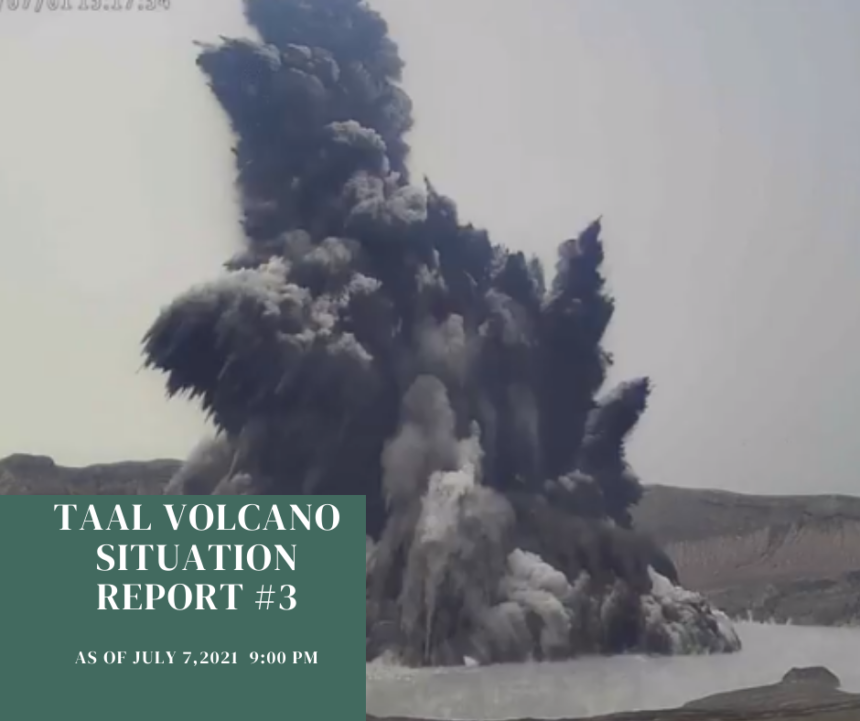Situation Overview
• Almost a week after a series of phreatomagmatic eruptions was observed in Taal on July 1, along with this, the Philippine Institute of Volcanology and Seismology (PHIVOLCS) maintains Alert Level 3 over Taal Volcano because of its activity. The authority called for the prompt evacuation of thousands of people living in barangays situated within the 7-kilometer danger zone of Taal Volcano following its phreatomagmatic eruptions.
• On July 4, Taal volcano emitted a record high amount of sulfur dioxide (22,628 tons, exceeding the previous high of 14,699 tons on Saturday, July 3, prompting PHIVOLCS to forecast another eruption.
• Taal Volcano’s sulfur dioxide (SO2) emission rested to an average of 5,299 tons per day on July 5, remarkably lower than the record high reached the previous day, but still at high level.
• On July 6, PHIVOLCS reiterated that at Alert level 3, there is a high probability of volcanic eruption.
• On July 7, PHIVOLCS observed more phreatomagmatic activity at Taal Volcano. Aside from the phreatomagmatic eruption caused by the interaction of water and magma at the crater, 55 volcanic earthquakes and high levels of sulfur dioxide emissions were also detected.
• The public is reminded that the entire Taal Volcano Island is a permanent danger zone, and entry into Agoncillo and Laurel must be prohibited.
Source: (DOST-Phivolcs, DSWD DROMIC Report and NDDRMC)
Affected Populations
• As of July 6, a total of 334 families or 1,996 persons are currently taking temporary shelter in 10 evacuation centers in the Municipality of Agoncillo while 123 families or 504 persons sought refuge in the homes of nearby relatives, according to data sent by STPRC.
• Meanwhile, a total of 457 families or 1,368 individuals were displaced in Laurel due to Taal’s phreatomagmatic eruption. Of which, 417 families were staying in 11 temporary shelters in Laurel and 40 families are outside the evacuation center. Most of the evacuees were from barangays Gulod, Buso-Buso, and Bugaan East in the municipality of Laurel, and barangays Bilibinwang, Banyaga and Subic Ilaya in the Municipaltiy of Agoncillo in Batangas.
• However, some of the residents of Taal opted to stay in their homes despite the threats of Taal Volcano eruption because of fear of losing their livelihood. Some residents whose livelihood is fishing are forced to sell their fish at lower prices.
• Covid-19 adds another risk to the families affected by the volcano because of overcrowding in evacuation centers. In case of Laurel, they have isolation facilities for sick individuals to reduce the threat of COVID-19 transmission. Vaccination stations have also been set up for those who have not been vaccinated.
Source: (DOST-Phivolcs, DSWD DROMIC Report, NDDRMC & STPRC)
Emergency Response Efforts
• CDRC is closely monitoring the situation through PHIVOLCS updates.
• CDRC is also closely coordinating with its regional center in affected areas to collect information on the situation and needs of the ground and constantly updating situation reports.
• On July 2, CDRC’s regional center “Southern Tagalog People’s Response Center (STPRC)” has mobilized a Rapid Damage Assessment and Needs Analysis team to conduct assessments in the affected areas while CDRC’s assessment team are placed on standby for possible mobilization.
• CDRC begins to release situation reports and posting updates and photos of the situation on their official FB page CDRC-Official Facebook Page including publicizing information like precautionary tips in case of a volcanic eruption.
Resources Available
• Standby emergency funds
• Prepositioned goods at the CDRC warehouse
• Monetary and in-kind donations
Expressed Needs
• Food supplies
• Clean water
• Hygiene kits
• Facemasks
• Primary medicines
• Sleeping materials
• Family tents
Coordination
1. Regional Center
Southern Tagalog People’s Response (STPRC)
Contacts
1. Hanna Fiel, Deputy Executive Director, 0945-8355589, hanna.fiel.cdrc2019@gmail.com
2. Cora Jazmines, Local Partnerships Department, 0928-182-4969, lpd@cdrc-phil.com

